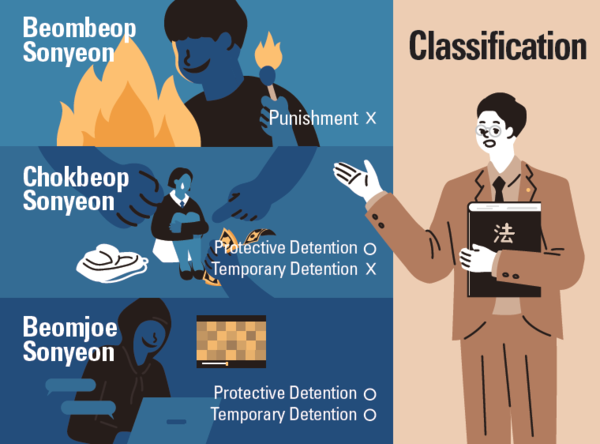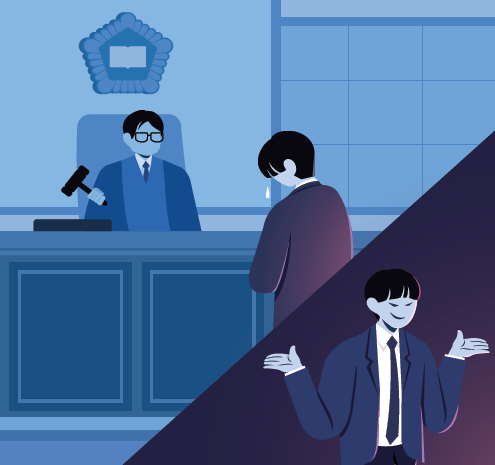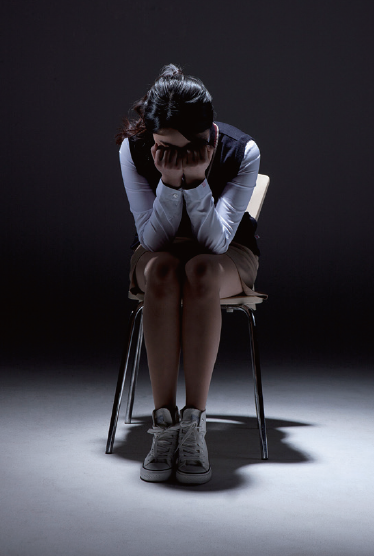Juvenile criminals and the Juvenile Act that protects them are currently at the center of controversy. Last August, a group of middle school girls from Ulsan City were investigated for violently assaulting a fellow male student. However, since they were juvenile delinquents, the perpetrators were expected to escape heavy punishments, which has drawn public outrage. With this, the debate of whether to abolish the law itself is reaching its peak. Let us delve into this debate of the Juvenile Act with the Sungkyun Times (SKT).
Immunity to Punishment
-Chokbeop, an Indulgence
Under the current Juvenile Act of South Korea, underage criminal offenders are classified into three categories: Beombeop Sonyeon, juveniles under 10 years old; Chokbeop Sonyeon, juveniles between 10-14 years old; and Beomjoe Sonyeon, juveniles between 14-19 years of age. Juveniles under 14 are defined as incompetent individuals with no clear understanding of law and judgment according to South Korean Law and hence receive protective measures such as being sent to reformatories and being handled in family courts rather than in regular courts. Acknowledging the issues regarding juvenile criminals, the South Korean legislature passed the Juvenile Act in 1958. The act’s purpose was to provide measures to control socially maladjusted juveniles and implement exceptions and protective detentions regarding their punishments. Through this legislation, the South Korean government aimed to prevent socially dependent minors under 14 years of age from being labeled criminals before they are fully integrated into society. With this intention, reformatories provide education, counseling, and assistance to underage criminals to help reintegrate them into society.

-A Glimpse of the Current Status
The Juvenile Act has undergone numerous amendments since its initial enactment in 1958. In 2002, the government made amendments to focus on rehabilitating and protecting juvenile criminals by banning the execution of minors. Furthermore, in 2008, the government made further adjustments regarding the age threshold and protection measures to mitigate the increasing cases involving underage criminals. With the final amendment in 2015, the current Juvenile Act imposes different punishments depending on the criminal’s age. First, Beombeop Sonyeon is punished by the criminal code. Second, Chokbeop Sonyeon is not subject to criminal punishment but may receive some protective detention regarding the gravity of the crime. Lastly, Beomjoe Sonyeon is subject to criminal punishment and prosecution, depending on the severity of the case. The crime rate of juvenile delinquents is constantly increasing. According to the Ministry of Justice (MOJ), the number of cases involving juvenile criminals doubled between 2013 to 2022. To address this alarming situation, the government proposed a downward adjustment of the age threshold by one year, making 13-year-old juvenile criminals subject to criminal punishments as well.
Should the Juvenile Act Be Abolished?
-A Purpose Unaccomplished: to Abolish

Controversies surrounding the rising cases of juvenile criminals have led to an ongoing argument for abolishing the Chokbeop system. Proponents of abolition claim that the law for juvenile criminals fails to achieve its purpose of reforming juveniles and preventing second offenses. Statistics of MOJ indicate that the recidivism rate of juvenile delinquencies is 12%, significantly higher than the 4.5% rate of adult criminals. Despite the law’s intent to lower re-offenses and achieve the reintegration of juvenile criminals, it failed to achieve any of these targets. Furthermore, another claim is that delinquents exploit the protective nature of the law by assuming they would be given an indulgence. In February 2022, a 13-year-old juvenile was caught stealing merchandise worth \6 million from over 20 unmanned stores. Upon arrest, the child claimed to the police officer that he would not get punished because he was underage, showing how juvenile delinquents may take advantage of the law. Moreover, cases of adults abusing this law have also occurred. In December 2022, a 20-year-old man lured two juveniles into stealing \35 million worth of goods by telling them they would not face punishment even if they got caught, due to the Juvenile Act. The public’s opinion on this controversy is leaning toward abolition because of such controversial cases.
-A Chance for the Youh: Not to Abolish
Opponents of the abolition claim that while there are concerns regarding the act, abolishing it is not the solution to the current status. They argue that juveniles must receive equal rehabilitation management as adult criminals. The main issue is that the system does not focus on the education of the juveniles. To lower reoffending rates, juveniles must be in an environment where they can learn new ways to be integrated. However, according to the MOJ, less than 50% of the imprisonment expense per juvenile in a reformatory is allotted to education and rehabilitation programs. In addition, prisons and similar facilities must ideally have an occupancy rate of no more than 70%. However, according to the 2021 to 2022 report from the MOJ, the reformatories had an occupancy rate of 80%. This overcrowding of reformatories will be an obstacle to successful rehabilitation and correction management. Despite these flaws, it is only through this act that juvenile delinquents will be given a chance at reintegration rather than lifelong criminal stigma. Such juvenile delinquents must be viewed as subjects of rehabilitation rather than punishment since strengthening punishment could hinder their potential to become positive contributors to society. Seung Jae-hyun, a researcher from the Korea Institute of Criminology and Justice, commented on the issue, “Since 1953, the law has changed countless times; the 14-year-old juveniles of 1953 are not the same 14-year-old juveniles of 2023.” Therefore, the time has come for the Juvenile Act to change.
A New Direction for the Juvenile Act
-Lowering the Age Threshold Is Not a Solution

In 2022, President Yoon Seok-yeol proposed an amendment to address the increasing cases of juvenile criminals. Because over 70% of those receiving protective measures are 13-year-olds, the proposed amendment aimed to lower the age threshold by one year, from 14 to 13. However, this adjustment is criticized for not effectively solving the current issue. Lowering the age threshold would make 13-year-olds subject to criminal punishments, which might stigmatize them as criminals and lead them to commit further crimes. Furthermore, the United Nations Committee on the Rights of the Child opposed lowering the age of crime responsibility, as many children under 14 lack the maturity to be held criminally responsible. Japan, where juvenile crime cases reached more than 260,000 at their peak, lowered the age threshold by two years in 2000 but saw no significant changes in crime rates. Similarly, in 2004, Denmark saw an increase in crime rates after taking down the age threshold by two years. These examples show that age reduction will not bring meaningful changes to juvenile crime rates. In addition, Attorney Ahn Ji-seong from Law- Win law firm told the SKT, “Solutions such as strengthening juvenile punishments are inconsistent with the Juvenile Act itself, therefore must never and cannot be actualized.”
-For Better Integration
Instead of lowering the age threshold or strengthening punishments, the government must raise alternative solutions. First, proper rehabilitation management is essential to address the alarmingly high crime and reoffending rates of juveniles. Current juvenile correction facilities need improvements in counseling, career guidance, and education. For example, Sweden hired psychologists and established proper education systems in juvenile facilities, which successfully reduced reoffending rates. South Korean juvenile facilities must also put more effort into educating and reintegrating juvenile delinquents, as the initial purpose of the act suggests. To achieve successful reintegration for each juvenile, the government must lower the facility-to-inmate ratio. By adjusting this ratio, youth offenders will be able to receive more detailed and personalized counseling that will educate them to be independent upon their discharge. Strengthening post-release monitoring and management of juvenile delinquencies is necessary as well. In 2022, government records showed a significant reduction in reoffending rates to 6.4% after the government increased supervision over released juvenile criminals. To fulfill the original purpose of the Juvenile Act by helping these juveniles adjust to society and integrating them as productive members of society, improvements to rehabilitation management are crucial.

The rough period of adolescence is a stage that many experience. While punishing criminals to protect victims is the duty of the law, providing opportunities for misguided youth is another. The SKT hopes that Kingos can view and analyze this matter from both sides of the debate.
